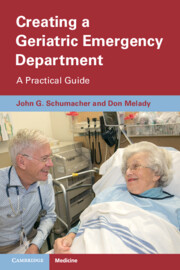29 results
Chapter 8 - Quality Improvement in the Geriatric Emergency Department: Getting Started
-
-
- Book:
- Creating a Geriatric Emergency Department
- Published online:
- 20 January 2022
- Print publication:
- 03 February 2022, pp 100-110
-
- Chapter
- Export citation
Introduction
-
- Book:
- Creating a Geriatric Emergency Department
- Published online:
- 20 January 2022
- Print publication:
- 03 February 2022, pp 1-3
-
- Chapter
- Export citation
Chapter 2 - Starting a Geriatric Emergency Department
-
- Book:
- Creating a Geriatric Emergency Department
- Published online:
- 20 January 2022
- Print publication:
- 03 February 2022, pp 17-31
-
- Chapter
- Export citation
Chapter 7 - Place: Addressing the Physical Environment
-
- Book:
- Creating a Geriatric Emergency Department
- Published online:
- 20 January 2022
- Print publication:
- 03 February 2022, pp 88-99
-
- Chapter
- Export citation
Chapter 3 - Overcoming Resistance: What to Do with “Yeah, But…”
-
- Book:
- Creating a Geriatric Emergency Department
- Published online:
- 20 January 2022
- Print publication:
- 03 February 2022, pp 32-39
-
- Chapter
- Export citation
Chapter 5 - People: Adding Staffing and Training
-
- Book:
- Creating a Geriatric Emergency Department
- Published online:
- 20 January 2022
- Print publication:
- 03 February 2022, pp 48-62
-
- Chapter
- Export citation
Dedication
-
- Book:
- Creating a Geriatric Emergency Department
- Published online:
- 20 January 2022
- Print publication:
- 03 February 2022, pp v-vi
-
- Chapter
- Export citation
Chapter 6 - Processes: Implementing Protocols and Policies
-
- Book:
- Creating a Geriatric Emergency Department
- Published online:
- 20 January 2022
- Print publication:
- 03 February 2022, pp 63-87
-
- Chapter
- Export citation
Acknowledgments
-
- Book:
- Creating a Geriatric Emergency Department
- Published online:
- 20 January 2022
- Print publication:
- 03 February 2022, pp viii-x
-
- Chapter
- Export citation
Chapter 4 - You: An Approach to Your Older Emergency Department Patients
-
- Book:
- Creating a Geriatric Emergency Department
- Published online:
- 20 January 2022
- Print publication:
- 03 February 2022, pp 40-47
-
- Chapter
- Export citation
Chapter 1 - Making the Case for a Geriatric Emergency Department
-
- Book:
- Creating a Geriatric Emergency Department
- Published online:
- 20 January 2022
- Print publication:
- 03 February 2022, pp 4-16
-
- Chapter
- Export citation
Index
-
- Book:
- Creating a Geriatric Emergency Department
- Published online:
- 20 January 2022
- Print publication:
- 03 February 2022, pp 137-142
-
- Chapter
- Export citation
Appendix: Practical Resources and Links
-
- Book:
- Creating a Geriatric Emergency Department
- Published online:
- 20 January 2022
- Print publication:
- 03 February 2022, pp 117-136
-
- Chapter
- Export citation
Contents
-
- Book:
- Creating a Geriatric Emergency Department
- Published online:
- 20 January 2022
- Print publication:
- 03 February 2022, pp vii-vii
-
- Chapter
- Export citation
Copyright page
-
- Book:
- Creating a Geriatric Emergency Department
- Published online:
- 20 January 2022
- Print publication:
- 03 February 2022, pp iv-iv
-
- Chapter
- Export citation
Chapter 9 - Launching Your Geriatric Emergency Department: From First Steps to Accreditation
-
- Book:
- Creating a Geriatric Emergency Department
- Published online:
- 20 January 2022
- Print publication:
- 03 February 2022, pp 111-116
-
- Chapter
- Export citation

Creating a Geriatric Emergency Department
- A Practical Guide
-
- Published online:
- 20 January 2022
- Print publication:
- 03 February 2022
Frailty: A key concept to improve older person care
-
- Journal:
- Canadian Journal of Emergency Medicine / Volume 22 / Issue 5 / September 2020
- Published online by Cambridge University Press:
- 23 September 2020, pp. 624-625
- Print publication:
- September 2020
-
- Article
-
- You have access
- HTML
- Export citation
Using volunteers to improve the experience of older patients in the emergency department
-
- Journal:
- Canadian Journal of Emergency Medicine / Volume 22 / Issue 4 / July 2020
- Published online by Cambridge University Press:
- 21 April 2020, pp. 514-518
- Print publication:
- July 2020
-
- Article
-
- You have access
- HTML
- Export citation
Age is just a number – and so is frailty: Strategies to inform resource allocation during the COVID-19 pandemic
-
- Journal:
- Canadian Journal of Emergency Medicine / Volume 22 / Issue 4 / July 2020
- Published online by Cambridge University Press:
- 01 April 2020, pp. 411-413
- Print publication:
- July 2020
-
- Article
-
- You have access
- Open access
- HTML
- Export citation

